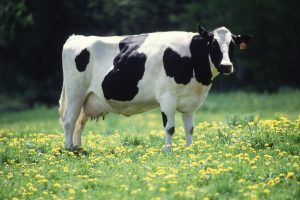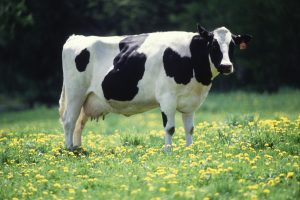Spring, on farms throughout the U.S., is marked by beginning of a new grass season. And when it arrives, cattle stop feeding on winter hay and go back to pasture. For farmers, “pasture” is a specific term that means paddocks of diverse grasses and plants — what celebrity farmer Joel Salatin refers to as a “salad bar” — the basis for every grazing animal’s natural diet.
Suddenly, this farm-based term is showing up in grocery stores on cartons of milk, on blocks of butter and cheese. “Pasture” and “pasture-raised” are becoming part of our food lingo. The question is, what does “pasture” really mean to us as consumers and eaters?
Here are five basic facts to remember when you’re choosing between conventional dairy products and these new offerings.
1. Pasture-raised is not the same as 100% grass-fed

http://www.ars.usda.gov/is/graphics/photos/k5176-3.htm
Like many food labels, the term “pasture” can be more confusing than clarifying since it has no legal definition and is unregulated. Generally, it infers that the cattle are granted some access to pasture though they may still be confined and fed grains. It also does not guarantee that the feed was antibiotic- and hormone-free (only the USDA Organic label, which is strictly defined and regulated, does that). By contrast, certified 100% grass-fed milk, butter and cheeses come from cows that grazed exclusively at nature’s salad bar. (Animal Welfare Approved has published the most extensive and understandable guide, a free download called Food Labels Exposed: A Definitive Guide to Common Food Labels Terms and Claims.)
2. It’s all about fats, the good kind
You wouldn’t think that grasses contain fats, but they do: essential fatty acids that get synthesized into the fats, including butterfats, of cattle that eat them. The more grasses dairy cattle consume in relation to grain, the higher the level of omega-3s — the good fat founds in flaxseed and fish. Products from 100% grass-fed animals has what nutritionists consider the ideal ratio of omega-3 and omega-6. CLA, or conjugated linoleic acid, is another fat desirable for its potential cancer-preventing, heart disease-reducing and supportive immune system properties. While health experts haven’t agreed on a daily intake for CLA, they all concur that we can all use more of it. And the only place to get it is from animal products from pastured animals that eat mostly grass.
3. Plus, antioxidants and vitamins
When cows spend more time on pasture, they consume more of the nutrients in grasses. Loads more of vitamins A and E as well as beta carotene are present in the pastured milk, butter and cheese, all believed to protect against cancer-causing free radicals and to boost immunity.
4. You can see the color and taste the difference
Those extra carotenes show up in the butterfat from pasture-raised animals. Do a test for yourself and compare pastured butter from a national producer such as Organic Valley to conventional butter. You’ll immediately notice how the pastured butter is sun gold yellow instead of pale. Spread each on a piece of toast and notice how the softer, unsaturated butterfat in the pastured butter spreads more smoothly while the butter from cows without access to pasture tends to crumble. Finally, taste each one (try it blind) to experience the depth and nuances of flavor you might have been missing.
5. It costs more. Here’s why.
Each year, the grass season only lasts so long. So production of pastured milk and butter is limited. Dairy products from animals that are 100% grass-fed — or raised on nothing but pasture — are more costly because the cows yield less milk than those raised in confinement dairies.
Copyright 2016 Lynne Curry via Zester Daily and Reuters Media Express
